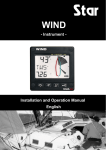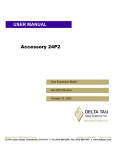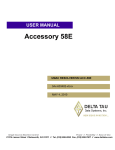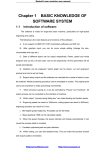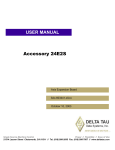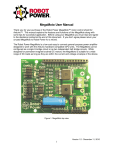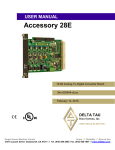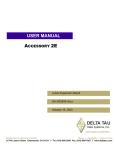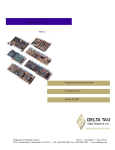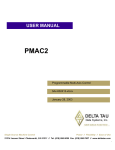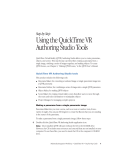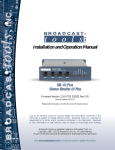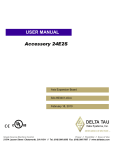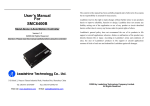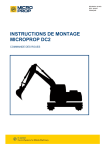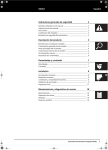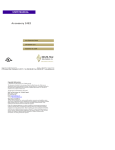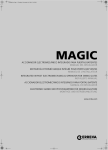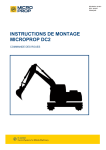Download ^1 USER MANUAL ^2 Accessory 24C2A
Transcript
^1 USER MANUAL ^2 Accessory 24C2A ^3 Compact UBUS 4-Axis Analog Servo Card ^4 4Ax-603611-xUxx ^5 October 15, 2003 Single Source Machine Control Power // Flexibility // Ease of Use 21314 Lassen Street Chatsworth, CA 91311 // Tel. (818) 998-2095 Fax. (818) 998-7807 // www.deltatau.com Copyright Information © 2003 Delta Tau Data Systems, Inc. All rights reserved. This document is furnished for the customers of Delta Tau Data Systems, Inc. Other uses are unauthorized without written permission of Delta Tau Data Systems, Inc. Information contained in this manual may be updated from time-to-time due to product improvements, etc., and may not conform in every respect to former issues. To report errors or inconsistencies, call or email: Delta Tau Data Systems, Inc. Technical Support Phone: (818) 717-5656 Fax: (818) 998-7807 Email: [email protected] Website: http://www.deltatau.com Operating Conditions All Delta Tau Data Systems, Inc. motion controller products, accessories, and amplifiers contain static sensitive components that can be damaged by incorrect handling. When installing or handling Delta Tau Data Systems, Inc. products, avoid contact with highly insulated materials. Only qualified personnel should be allowed to handle this equipment. In the case of industrial applications, we expect our products to be protected from hazardous or conductive materials and/or environments that could cause harm to the controller by damaging components or causing electrical shorts. When our products are used in an industrial environment, install them into an industrial electrical cabinet or industrial PC to protect them from excessive or corrosive moisture, abnormal ambient temperatures, and conductive materials. If Delta Tau Data Systems, Inc. products are directly exposed to hazardous or conductive materials and/or environments, we cannot guarantee their operation. Accessory 24C2A Table of Contents INTRODUCTION .......................................................................................................................................................1 Overview ...................................................................................................................................................................1 Features .....................................................................................................................................................................1 Board Configuration..................................................................................................................................................2 ACC-24C2A Power Supply Requirements ...............................................................................................................2 BOARD LAYOUT.......................................................................................................................................................3 E-POINT JUMPER SETTINGS ................................................................................................................................5 ACC-24C2A (Channels* 1, 2, 3, 4) ..........................................................................................................................5 HARDWARE SETUP .................................................................................................................................................7 Switch Configuration ................................................................................................................................................7 UMAC Turbo CPCI Address DIP Switch S1 ........................................................................................................7 ACC-24C2A Clock Settings .....................................................................................................................................7 UMAC CPCI Clock Setup for ACC-24C2A ..........................................................................................................7 UMAC MACRO CPCI Clock Setup for ACC-24C2A ...........................................................................................7 Resistor Pack Configuration......................................................................................................................................7 Termination Resistors Packs ................................................................................................................................7 Encoder Loss Resistor Packs................................................................................................................................8 Limit/Flag Voltage Level Resistor Packs..............................................................................................................8 Opto-Isolation Considerations...................................................................................................................................9 Limit/Flag Circuit....................................................................................................................................................10 Connecting Limits/Flags to the ACC-24C2A......................................................................................................11 Amplifier Fault Circuit............................................................................................................................................11 Loss of Encoder Circuit...........................................................................................................................................12 Position Compare Port Driver IC ............................................................................................................................13 UMAC TURBO CPCI SOFTWARE SETUP .........................................................................................................15 Servo IC Configuration I-Variables ........................................................................................................................15 Servo IC Numbering ...........................................................................................................................................15 Servo Channel Numbering..................................................................................................................................15 Multi-Channel I-Variables..................................................................................................................................15 Single-Channel I-Variables ................................................................................................................................16 Encoder Conversion Table I-Variables ..............................................................................................................17 Motor Addressing I-Variables ............................................................................................................................17 UMAC Turbo CPCI Example Setups......................................................................................................................21 MLDT FEEDBACK SETUP ....................................................................................................................................23 MLDT Hardware Setup of the ACC-24C2A...........................................................................................................23 MLDT Software Setup of the UMAC Turbo CPCI.................................................................................................23 Hardware Setup I-Variables for Servo IC m ......................................................................................................23 Conversion Table Processing I-Variables ..........................................................................................................23 Motor I-Variables ...............................................................................................................................................24 Pulse Output Frequency .....................................................................................................................................25 12-BIT ADC OPTION...............................................................................................................................................27 PINOUT DESCRIPTION .........................................................................................................................................29 Table of Contents i Accessory 24C2A ii Table of Contents Accessory 24C2A INTRODUCTION Overview The ACC-24C2A Axis Expansion Board is a single-slot module providing the interface circuitry for 4 axes, either analog interface for torque or velocity mode amplifiers or pulse and direction output for stepper motor drives. It has a ‘slave’ Compact-UBUS interface on its J1 connector and the servo interface signals are on the J2 connector. Opto isolation is maintained between the analog circuitry and the digital circuitry to isolate the main axis flags. The ACC-24C2A is part of the CPCI family of expansion cards and these accessory cards are designed to plug into an industrial CPCI rack system. The information from these accessories is passed directly to either the UMAC Turbo CPCI CPU via the high speed Compact UBUS. Other Compact UBUS interface cards include the following: • • • • • ACC-11C General purpose 96-point I/O card with short circuit protection Up to eight ACC-24C2A boards can be connected to one UMAC Turbo CPCI system, providing up to 32 additional channels of servo interface circuitry. The ACC-24C2A board contains no processor; it has 1 highly integrated 4-channel PMAC2-style “Servo IC” with the buffering circuitry and connectors around them. Some new features added to the family of ACC-24C2A breakout boards include: Loss of encoder circuit 5V to 24V Flag inputs Pulse and direction outputs for stepper systems or MLDTs 12-bit ADC option Features The ACC-24C2A board can be used with any UMAC Turbo CPCI, interfacing through the Compact UBUS. The ACC-24C2A supports a wide variety of servo and stepper interfaces: • • • • • Analog +/-10V velocity commands Analog +/-10V torque commands Sinusoidal analog +/-10V phase current commands Pulse-and-direction commands Eight 12-bit ADC inputs Introduction 1 Accessory 24C2A Board Configuration An ACC-24C2A comes standard with one Servo IC providing four servo interface channels, which are brought out on the P2 connectors on the ‘backside’ of the Compact UBUS backplane board. Each channel of servo interface circuitry includes the following: • • • • • Two output command signal sets, configurable as either: 1 pulse-and-direction 2 DAC outputs Three-channel differential/single-ended encoder input Sixteen input flags, 4 Amplifier enable outputs ACC-24C2A Power Supply Requirements The following table lists the power requirements for the ACC-24C2A. 2 Product 5V 12V for DACs -12V for DACs ACC-24C2A 1000mA 400mA 400mA Introduction Accessory 24C2A BOARD LAYOUT Board Layout 3 Accessory 24C2A 4 Board Layout Accessory 24C2A E-POINT JUMPER SETTINGS ACC-24C2A (Channels* 1, 2, 3, 4) Jumper Config. E1 1-2-3 Description Default Jump 1-2 for UMAC MACRO CPCI (receive servo Factory set and phase clock) Jump 2-3 for UMAC Turbo CPCI (source servo and phase clock) E2 1-2 No Jumper for TTL Level input for CHU1, CHV1, No jumper CHW1, CHT1 Jumper 1-2 for DIR1+,DIR1-, PUL1+, PUL1- for stepper mode E3 1-2 No Jumper for TTL Level input for CHU2, CHV2, No jumper CHW2, CHT2 Jumper 1-2 for DIR2+,DIR2-, PUL2+, PUL2- for stepper mode E4 1-2 No Jumper for TTL Level input for CHU3, CHV3, No jumper CHW3, CHT3 Jumper 1-2 for DIR3+,DIR3-, PUL3+, PUL3- for stepper mode E5 1-2 No Jumper for TTL Level input for CHU4, CHV4, No jumper CHW4, CHT4 Jumper 1-2 for DIR4+,DIR4-, PUL4+, PUL4- for stepper mode E85 1-2 Jump 1-2 for Backplane Supplied +15V Jump 1-2 No Jumper for External Supplied +15V E87 1-2 Jump 1-2 for Backplane Supplied AGND Jump 1-2 No Jumper for External Supplied AGND E88 1-2 Jump 1-2 for Backplane Supplied -15V Jump 1-2 No Jumper for External Supplied -15V OPT1 1-2 For factory use only OPT2 1-2 For factory use only The channels refer to the Servo IC associated with the ACC-24C2A board. For example, an eight-axis application would have two ACC-24C2As. The first ACC-24C2A would have axes 1-4 and the second ACC-24C2A would contain axes 5-8. E-Point Jumper Settings 5 Accessory 24C2A 6 E-Point Jumper Settings Accessory 24C2A HARDWARE SETUP Switch Configuration UMAC Turbo CPCI Address DIP Switch S1 S1, S1-3, S1-4 are used to address the ACC-24C2A as shown in the table below. S1-1 S1-3 S1-4 Board No. IC No. I-Var. Range Base Address ON OFF ON OFF ON OFF ON OFF ON ON OFF OFF ON ON OFF OFF ON ON ON ON OFF OFF OFF OFF 1 2 3 4 5 6 7 8 2 3 4 5 6 7 8 9 I7200 I7300 I7400 I7500 I7600 I7700 I7800 I7900 $078200 $078300 $079200 $079300 $07A200 $07A300 $07B200 $07B300 S1-2, S1-5, and S1-6 are used to determine whether or not the ACC-24C2A is communicating to a UMAC Turbo CPCI. S1-2 S1-5 S1-6 Function ON ON ON UMAC Turbo CPCI Use ACC-24C2A Clock Settings The Phase Clock and Servo Clock must be configured on each ACC-24C2A base board to ensure proper operation. Each system can have only one source for the servo and phase clocks and jumpers must be set appropriately to avoid a timing conflict and a watchdog condition. There are two methods to set the phase clock and servo clock for the ACC-24C2A: UMAC Turbo MACRO CPCI Setup. UMAC CPCI Clock Setup for ACC-24C2A Starting in Turbo firmware version 1.937, the firmware will automatically set the clock settings for the ACC-24C2A cards in the Compact UBUS. The user will have to set jumper E1 from 2 to 3 for all of the ACC-24C2A’s plugged into the Compact UBUS to enable this feature. At power up, the firmware will know that all of the cards are in the auto configuration setup and will assign the card with the lowest base address setting (usually $78200) the task of sourcing the clocks by setting variable I19 to the appropriate register. The clocks will initially be set the factory default servo update cycle and phase clock cycle. UMAC MACRO CPCI Clock Setup for ACC-24C2A To manually setup the clock sources UMAC MACRO CPCI, the user must set of the ACC-24C2A’s to receive the phase and servo clock (E1 set 1-2). Resistor Pack Configuration Termination Resistors Packs The ACC-24C2A provides sockets for termination resistors on differential input pairs coming into the board. As shipped, there are no resistor packs in these sockets. If these signals are brought long distances into the ACC-24C2A board and ringing at signal transitions is a problem, SIP resistor packs may be mounted in these sockets to reduce or eliminate the ringing. All termination resistor packs are the types that have independent resistors (no common connection) with each resistor using two adjacent pins. Hardware Setup 7 Accessory 24C2A Encoder Loss Resistor Packs The ACC-24C2A also provides an encoder loss circuit to detect if the quadrature signals are valid. To activate this feature the user must reverse the resistor pack from its default configuration. Limit/Flag Voltage Level Resistor Packs The ACC-24C2A limit and flag circuits also give the user the flexibility to wire in standard 12V to 24V limits and flags or they could wire in 5V level limits and flags on a channel basis (each ACC-24C2 has 4 channels). The default is set for the standard 12V to 24V inputs but if the resistor pack is added to the circuit the card can read 5V inputs. Channel Specific Resistor Packs 8 Channel #1 Channel #2 Channel #3 Channel #4 SIP Description RP33 RP34 RP63 RP64 2.2KΩ RP37 RP38 RP67 RP68 220Ω RP14 RP18 RP23 RP27 1KΩ Reverse resistor pack for encoder loss feature (for differential encoders only) Termination resistor to reduce ringing (not installed by default). Install for 5V limits (not installed by default). Hardware Setup Accessory 24C2A Compact UBUS Specific Resistor Packs Resistor Pack SIP Description RP3 RP5 RP6 110Ω 220Ω 2.2 KΩ Terminator for line receivers (always installed) Terminator (not installed, only used for non-CPCI Bus) Biasing resistor in pull down mode for non-terminating backplane (always installed) Opto-Isolation Considerations As shipped from the factory, the ACC-24C2A obtains its power from the Compact UBUS Backplane. Using this type of setup will defeat opto isolation since the analog ground plane will be tied directly to the digital ground plane? If the user wants to optically isolate the analog ground plane from the digital ground plane, they will have to connect an external power supply the AA+15V, AA-15V, and AAGND inputs on the ACC-24C2A. The user must also remove the E85, E87, and E88 jumpers to isolate the external power from the Compact UBUS power supplies. (ON HEATSINK) TP6 A+14V 56uh MBRS140T3 + C2 22UF 25V + AA+5V D3 A-15V MBRS140T3 Hardware Setup L2 56uh + C5 22UF 25V OUT 1 + C43 22UF 25V + C42 22UF 25V D9 1SMC18AT3 AAGND D14 2 + C44 22UF 25V TP5 A-14V 1SMC18AT3 D8 A-14V E88 1 E88 IN AAGND E87 C4 22UF 25V 3 C45 1UF 50V TP3 AAGND 1 E87 R42 18 OHM 2.25W (TO-220) VR1 LM7805T TP4 AA+5V C3 22UF 25V AGND + AA+15V MBRS140T3 2 GND 1 E85 2 D2 A+15V D7 A+14V E85 L1 AA-15V MBRS140T3 2 "AGND" PLANE 9 Accessory 24C2A Limit/Flag Circuit The ACC-24C2A allows the user to use sinking or sourcing position limits and flags to the controller. The optoisolator IC used is a PS2701 photo-transistor output type. This IC allows the current to flow from return to flag (sinking) or from flag to return (sourcing). A sample of the positive limit circuit is shown below. The 4.7K resistor packs used will allow 12-24V flag inputs. If 0V to 5V voltage flags are used, then a 1KΩ resistor pack (RP) can be placed in either RP45 or RP46 (please refer to the Resistor Pack description section of this manual). If the user does add these resistor packs, all flags (±Limits, Home, User, and amplifier fault) will be referenced from 0V to 5V. 10 Hardware Setup Accessory 24C2A Connecting Limits/Flags to the ACC-24C2A The following diagrams illustrate the sinking and sourcing connections to an ACC-24C2A. For this example we are assuming the use of 12-24V flags. Sinking, Separate Supply Sourcing, Separate Supply Amplifier Fault Circuit The amplifier fault circuit for the ACC-24C2A is functionally the same circuit as the limits and flag circuit. +5V R20 2.2K FAULT_1 FAULT_2 FAULT_1 FAULT_2 "DGND" PLANE "AGND" PLANE R21 2.2K U23A 4 3 C1 E1 4 3 C1 E1 R22 1K A1 C1 A1 C1 U23B PS2701-1 GND 1 2 1 3 5 7 1 2 R23 1K RP41 2 4 6 8 AFAULT_1+ AFAULT_2+ 4.7KSIP8I FAULTRET For single ended amplifier fault inputs, typically the AFAULT+ would be the actual signal input from the amplifier and the AFAULT- can be considered the reference. Hardware Setup 11 Accessory 24C2A Single Ended Amplifier Fault Inputs AFault+ AFault- Input Type 0V 12V to 24V +12V to 24V 0V Sinking – Low True Sourcing – High True Loss of Encoder Circuit The encoder-loss detection circuitry works only for differential incremental encoders. In proper operation, the digital states of the complementary inputs for a channel (e.g. A and A/) should always be opposite: when one is high, the other is low. If for some reason, such as a cable connection coming undone, one or more of the signal lines is no longer driven, pull-up resistors on the input line pull and hold the signal high. The encoder-loss detection circuitry uses “exclusive-or” (XOR) gates on each complementary pair to detect whether the signals are in the same or opposite states. These results are combined to produce a single “encoder-loss” status bit that the processor can read. This technique requires that both signal lines of the pair have pull-up resistors. Note that this is not the default configuration of a PMAC as it is shipped. The complementary lines (A/ and B/) are pulled to 2.5V in a voltage-divider configuration as shipped to be able to accept both single-ended and normal differential inputs. This must be changed to a pull-up configuration which involves reversing a socketed resistor pack on the ACC-24C2A. ACC-24C2A Discrete On-board Logic with UMAC Turbo CPCI Channel Resistor Pack Status Bit Address (EvenNumbered Servo IC)* Status Bit Address (OddNumbered Servo IC)* Status Bit “Name” Bit Error State 1 RP43 Y:$07xF08,5 Y:$07xF0C,5 QL_10 2 RP48 Y:$07xF09,5 Y:$07xF0D,5 QL_20 3 RP44 Y:$07xF0A,5 Y:$07xF0E,5 QL_30 4 RP49 Y:$07xF0B,5 Y:$07xF0F,5 QL_40 *The “x” digit in this hex address matches the value (8, 9, A, or B) in the fourth digit from the right in the board’s own base address (e.g. $079200). If alternate addressing of Servo ICs is used (e.g. Servo IC 2*), add $20 to these addresses. 12 Hardware Setup Accessory 24C2A Position Compare Port Driver IC As with the other PMAC controllers, the UMAC Turbo CPCI has the high-speed position compare outputs allowing the user to fire an output based on position. This circuit will fire within 100 nsec of reaching the desired position. The position compare output port on the ACC-24C2A and its Option 1 daughter card have a socketed driver IC in a 8-pin DIP socket at component U27. This IC gives the user a fast CMOS driver. The following table lists the properties of each driver IC: Part # of Pins Max Voltage & Current Output Type Max Frequency E11, E12 Setting DS75451N 8 5V, 10 mA Totem-Pole (CMOS) 5 MHz 1-2 Hardware Setup 13 Accessory 24C2A 14 Hardware Setup Accessory 24C2A UMAC TURBO CPCI SOFTWARE SETUP Servo IC Configuration I-Variables Turbo PMAC2 I-variables in the range I7200 – I7999 control the configuration of the Servo ICs. The hundred’s digit represents the number of the Servo IC (2 to 9) in the system. Servo IC Numbering The number ‘m’ of the Servo IC on the ACC-24C2A board is dependent on the addressing of the board with DIP switches S1-1, S1-3, and S1-4, which place the board as the 1st through 8th external device: • • • • • • • • 1st ACC-24C2A: 2nd ACC-24C2A: Servo IC 2 (channels 1-4) Servo IC 3 (channels 5-8) 3rd ACC-24C2A: 4th ACC-24C2A: 5th ACC-24C2A: 6th ACC-24C2A: 7th ACC-24C2A: Servo IC 4 (channels 9-12) Servo IC 5 (channels 13-16) Servo IC 6 (channels 17-20) Servo IC 7 (channels 21-24) Servo IC 8 (channels 25-28) 8th ACC-24C2A: Servo IC 9 (channels 29-32) Servo Channel Numbering Each Servo IC has 4 channels of servo interface circuitry. The ten’s digit ‘n’ of the I-variable configuring the IC represents the channel number on the IC (n = 1 to 4). For example, Channel 1 of the “Standard” Servo IC on the 1st ACC-24C2A is configured by variables I7210 – I7219. These channel-specific Ivariables are represented generically as I7mn0 – I7mn9, where ‘m’ represents the Servo IC number (0 – 9) and ‘n’ represents the IC channel number (1 – 4). The Channels 1 – 4 on the “Standard” Servo IC of an ACC-24C2A correspond to Channels 1 – 4, respectively, on the ACC-24C2A board itself. I-variables in the I7000s for which the ten’s digit is ‘0’ (“Channel 0”) affect all 4 channels of the PMAC2-style Servo IC on the ACC-24C2A. These multi-channel I-variables are represented generically as I7m00 – I7m09. Multi-Channel I-Variables There are several multi-channel I-variables that must be set up properly for proper operation of the ACC24C2A in a Turbo PMAC system. The most important are: • • I7m07: Servo IC m Phase/Servo Clock Direction: This variable should be set to 0 the ACC24CPCI generating the clocks and set to 3 for the ACC-24C2A’s receiving the clocks. The setting I7m07 is automatically setup by the UMAC Turbo CPCI firmware. I7m00: Servo IC m MaxPhase/PWM Frequency Control: Typically this will be set to the same value as the variable that controls the system clocks: I7200 on UMAC Turbo CPCI. If a different PWM frequency is desired, or the ACC-24C2A then the following constraint should be observed in setting this variable: 2 * PWMFreq( kHz ) = { Integer } PhaseFreq UMAC Turbo CPCI Software Setup 15 Accessory 24C2A • I7m01: Servo IC m Phase Clock Frequency Control: Even though the IC is receiving an external phase clock (see I7m07, above), it is usually best to create the same internal phase clock frequency in the Servo IC. This yields the following constraint: I 7 m00 * ( I 7 m01 + 1 ) = I 7200 * ( I 7201 + 1 ) {UMAC Turbo CPCI} Solving for I7m01, we get I 7 m01 = I 7200 * ( I 7201 + 1 ) −1 {UMAC Turbo CPCI} I 7 m00 If I7m00 is the same as I7200, I7m01 will be the same as I7201 I7m02: Servo IC m Servo Clock Frequency Control: Even though the IC is receiving an external servo clock (see I7m07, above), it is usually best to create the same internal servo clock frequency in the Servo IC. This means that I7m02 for the IC should be set the same as I7202 on a UMAC Turbo CPCI. • I7m03: Servo IC m Hardware Clock Frequency Control: The hardware clock frequencies for the Servo IC should be set according to the devices attached to it. There is no reason for these frequencies to be the same between ICs. There is seldom a reason to change this value from the default. Single-Channel I-Variables The single-channel setup I-variables for Channel ‘n’ of Servo IC ‘m’ work exactly the same on an ACC24C2A as they do on a standard Turbo PMAC2 itself. Each Servo IC has 4 channels ‘n’, numbered 1 to 4. For the first (standard) Servo IC on the ACC-24C2A, the channel numbers 1 – 4 on the Servo IC are the same as the channel numbers 1 – 4 on the board. The most important variables are: • • • • 16 I7mn0: Servo IC m Channel n Encoder Decode Control: Typically, I7mn0 is set to 3 or 7 for “x4” quadrature decode, depending on which way is “up.” If the channel is used for open-loop stepper drive, I7mn0 is set to 8 to accept internal pulse-and-direction or to 0 to accept external pulseand-direction (e.g. from an ACC-8S). It is set to 12 if the channel is used for MLDT feedback. I7mn2: Servo IC m Channel n Capture Control: I7mn2 determines whether the encoder index channel, an input flag, or both, are used for the capture of the encoder position. I7mn3: Servo IC m Channel n Capture Flag Select: I7mn3 determines which input flag is used for encoder capture, if one is used. I7mn6: Servo IC m Channel n Output Mode Select: I7mn6 determines whether the A and B outputs are DAC or PWM, and whether the C output is PFM (pulse-and-direction) or PWM. Typically, it is set either to 0, for 3-phase PWM, or to 3 for DACs and PFM. UMAC Turbo CPCI Software Setup Accessory 24C2A Encoder Conversion Table I-Variables To use feedback or master position data from an ACC-24C2A, you must add entries to the encoder conversion table (ECT) using I-variables I8000 – I8191 to address and process this data. The default conversion table in the Turbo PMAC does not contain these entries; it only contains entries for the 8 channels on board the Turbo PMAC. Usually, the position data obtained through an ACC-24C2A board is an incremental encoder feedback, and occasionally an A/D converter feedback from the ADC option on this card. The ECT entries for ACC-24C2A incremental encoder channels are shown in the following table: Encoder Channel # 1st & 2nd ACC24C2A 3rd & 4th ACC24C2A 5th and 6th ACC24C2A 7th and 8th ACC24C2A Channel 1 Channel 2 Channel 3 Channel 4 Channel 5 Channel 6 Channel 7 Channel 8 $m78200 $m78208 $m78210 $m78218 $m78300 $m78308 $m78310 $m78318 $m79200 $m79208 $m79210 $m79218 $m79300 $m79308 $m79310 $m79318 $m7A200 $m7A208 $m7A210 $m7A218 $m7A300 $m7A308 $m7A310 $m7A318 $m7B200 $m7B208 $m7B210 $m7B218 $m7B300 $m7B308 $m7B310 $m7B318 The first hexadecimal digit in the entry, represented by ‘m’ in the table, is a ‘0’ for the most common 1/T timer-based extension of digital incremental encoders; it is an ‘8’ for the parallel-data extension of analog incremental encoders; it is a ‘C’ for no extension of an incremental encoder. Motor Addressing I-Variables For a Turbo PMAC motor to use the servo interface circuitry of the ACC-24C2A, several of the addressing I-variables for the motor must contain the addresses of registers in the ACC-24C2A, or the addresses of encoder conversion table registers containing data processed from the ACC-24C2A. These I-variables can include: • Ixx02: Motor xx Command Output Address: Ixx02 tells Turbo PMAC where to write its command outputs for Motor xx. If ACC-24C2A is to create the command signals, Ixx02 must contain the address of the register. The following table shows the address of the ‘A’ output register for each channel of each ACC-24C2A. These addresses can be used for single analog outputs, double analog outputs, or direct PWM outputs. UMAC Turbo CPCI Software Setup 17 Accessory 24C2A ACC-24C2A Register: Board No. & Channel 1st ACC-24C2A DAC/PWM1A 1st ACC-24C2A DAC/PWM2A 1st ACC-24C2A DAC/PWM3A 1st ACC-24C2A DAC/PWM4A 2nd ACC-24C2A DAC/PWM1A 2nd ACC-24C2A DAC/PWM2A 2nd ACC-24C2A DAC/PWM3A 2nd ACC-24C2A DAC/PWM4A 3rd ACC-24C2A DAC/PWM1A 3rd ACC-24C2A DAC/PWM2A 3rd ACC-24C2A DAC/PWM3A 3rd ACC-24C2A DAC/PWM4A 4th ACC-24C2A DAC/PWM1A 4th ACC-24C2A DAC/PWM1A 4th ACC-24C2A DAC/PWM2A 4th ACC-24C2A DAC/PWM4A Address / Ixx02 Value UMAC Turbo CPCI ACC-24C2A Register: Board No. & Channel Address / Ixx02 Value UMAC Turbo $078202 I102 $07A202 I1702 $07820A I202 $07A20A I1802 $078212 I302 $07A212 I1902 $07821A I402 $07A21A I2002 $078302 I502 $07A302 I2102 $07830A I602 $07A30A I2202 $078312 I702 $07A312 I2302 $07831A I802 $07A31A I2402 $079202 I902 $07B202 I2502 $07920A I1002 $07B20A I2602 $079212 I1102 $07B212 I2702 $07921A I1202 $07B21A I2802 $079302 I1302 $07B302 I2902 $07930A I1402 $07B30A I3002 $079312 I1502 $07B312 I3102 $07931A I1602 5th ACC-24C2A DAC/PWM1A 5th ACC-24C2A DAC/PWM2A 5th ACC-24C2A DAC/PWM3A 5th ACC-24C2A DAC/PWM4A 6th ACC-24C2A DAC/PWM1A 6th ACC-24C2A DAC/PWM2A 6th ACC-24C2A DAC/PWM3A 6th ACC-24C2A DAC/PWM4A 7th ACC-24C2A DAC/PWM1A 7th ACC-24C2A DAC/PWM2A 7th ACC-24C2A DAC/PWM3A 7th ACC-24C2A DAC/PWM4A 8th ACC-24C2A DAC/PWM1A 8th ACC-24C2A DAC/PWM2A 8th ACC-24C2A DAC/PWM3A 8th ACC-24C2A DAC/PWM4A $07B31A I3202 CPCI If the ‘C’ output register for a given ACC-24C2A and channel is used (primarily for pulse and direction output), simply add 2 to the address shown in the above table. For example, on the first ACC-24C2A, output register 1C is at address $078204. Ixx03: Motor xx Position-Loop Feedback Address Ixx04: Motor xx Velocity-Loop Feedback Address Ixx05: Motor xx Master Position Address The Ixx03, Ixx04, and Ixx05 variables almost always contain the address of a processed position value in the encoder conversion table, even when the raw data comes from the ACC-24C2A. The first line of the encoder conversion table is at address $003501; the last line is at address $0035C0. Ixx10: Motor xx Power-On Position Address: Ixx10 tells the Turbo PMAC where to read absolute power-on position, if any. Typically, the only times Ixx10 will contain the address of an ACC-24C2A register is if the position is obtained from an A/D converter from the ACC-24C2A, or if it is obtained from an MLDT (e.g. TemposonicsTM) sensor excited directly from an ACC-24C2A. 18 UMAC Turbo CPCI Software Setup Accessory 24C2A The following table shows the possible values of Ixx10 for MLDT timer registers: Ixx10 for ACC-24C2A MLDT Timer Registers (Ixx95=$170000) • MLDT Timer Channel # 1st & 2nd ACC-24C2A 3rd & 4th ACC-24C2A 5th & 6th ACC-24C2A 7th & 8th ACC-24C2A Channel 1 Channel 2 Channel 3 Channel 4 Channel 5 Channel 6 Channel 7 Channel 8 $078200 $078208 $078210 $078218 $078300 $078308 $078310 $078318 $079200 $079208 $079210 $079218 $079300 $079308 $079310 $079318 $07A200 $07A208 $07A210 $07A218 $07A300 $07A308 $07A310 $07A318 $07B200 $07B208 $07B210 $07B218 $07B300 $07B308 $07B310 $07B318 Ixx24: Motor xx Flag Mode: Ixx24 defines how to read and use the flags for Motor xx that are in the register specified by Ixx25. Ixx24 is a set of independent control bits. There are two bits that must be set correctly to use a flag set on an ACC-24C2A. Bit 0 of Ixx24 must be set to 1 to tell the Turbo PMAC that this flag set is in a “Type 1” PMAC2style Servo IC. Bit 18 of Ixx24 must be set to 0 to tell the Turbo PMAC that this flag set is not transmitted over a MACRO ring. Other bits of Ixx24 may be set as desired for a particular application. • Ixx25: Motor xx Flag Address: Ixx25 tells Turbo PMAC where to access its flag data for Motor xx. If ACC-24C2A is interfaced to the flags, Ixx25 must contain the address of the flag register in ACC24C2A. The following table shows the address of the flag register for each channel of each ACC24C2A. ACC-24C2A Register: Board No. & Channel Address / Ixx25 Value UMAC Default for: ACC-24C2A Register: Board No. & Channel Address / Ixx25 Value UMAC Default for: 1st ACC-24C2A Flag Set 1 1st ACC-24C2A Flag Set 2 1st ACC-24C2A Flag Set 3 1st ACC-24C2A Flag Set 4 2nd ACC-24C2A Flag Set 1 2nd ACC-24C2A Flag Set 2 2nd ACC-24C2A Flag Set 3 2nd ACC-24C2A Flag Set 4 3rd ACC-24C2A Flag Set 1 3rd ACC-24C2A Flag Set 2 3rd ACC-24C2A Flag Set 3 3rd ACC-24C2A Flag Set 4 4th ACC-24C2A Flag Set 1 4th ACC-24C2A Flag Set 2 4th ACC-24C2A Flag Set 3 4th ACC-24C2A Flag Set 4 $078200 $078208 $078210 $078218 $078300 $078308 $078310 $078318 $079200 $079208 $079210 $079218 $079300 $079308 $079310 $079318 I125 I225 I325 I425 I525 I625 I725 I825 I925 I1025 I1125 I1225 I1325 I1425 I1525 I1625 5th ACC-24C2A Flag Set 1 5th ACC-24C2A Flag Set 2 5th ACC-24C2A Flag Set 3 5th ACC-24C2A Flag Set 4 6th ACC-24C2A Flag Set 1 6th ACC-24C2A Flag Set 2 6th ACC-24C2A Flag Set 3 6th ACC-24C2A Flag Set 4 7th ACC-24C2A Flag Set 1 7th ACC-24C2A Flag Set 2 7th ACC-24C2A Flag Set 3 7th ACC-24C2A Flag Set 4 8th ACC-24C2A Flag Set 1 8th ACC-24C2A Flag Set 2 8th ACC-24C2A Flag Set 3 8th ACC-24C2A Flag Set 4 $07A200 $07A208 $07A210 $07A218 $07A300 $07A308 $07A310 $07A318 $07B200 $07B208 $07B210 $07B218 $07B300 $07B308 $07B310 $07B318 I1725 I1825 I1925 I2025 I2125 I2225 I2325 I2425 I2525 I2625 I2725 I2825 I2925 I3025 I3125 I3225 • Ixx81: Motor xx Power-On Phase Position Address: Ixx81 tells Turbo PMAC2 where to read absolute power-on position for motor phase commutation, if any. Typically, it will contain the address of an ACC-24C2A register for only two types of absolute phasing sensors: hall-effect commutation sensors (or their optical equivalents) connected to the U, V, and W input flags on an ACC-24C2A channel. UMAC Turbo CPCI Software Setup 19 Accessory 24C2A The following table contains the possible settings of Ixx81 for hall sensor absolute position with an ACC-24C2A: Turbo PMAC Ixx81 ACC-24C2A Hall Phasing Settings (Ix91=$800000 - $FF0000) Hall Flag Channel # 1st & 2nd ACC-24C2A 3rd & 4th ACC-24C2A 5th & 6th ACC-24C2A 7th & 8th ACC24C2A Channel 1 Channel 2 Channel 3 Channel 4 Channel 5 Channel 6 Channel 7 Channel 8 $078200 $078208 $078210 $078218 $078300 $078308 $078310 $078318 $079200 $079208 $079210 $079218 $079300 $079308 $079310 $079318 $07A200 $07A208 $07A210 $07A218 $07A300 $07A308 $07A310 $07A318 $07B200 $07B208 $07B210 $07B218 $07B300 $07B308 $07B310 $07B318 The following table contains the possible settings of Ixx81 to read the encoder counters for Yaskawa absolute encoders: Turbo PMAC Ixx81 ACC-24C2A Encoder Register Settings (Ix91=$480000 - $580000) • Encoder Register Channel # 1st & 2nd ACC24C2A 3rd & 4th ACC24C2A 5th & 6th ACC24C2A 7th & 8th ACC-24C2A Channel 1 Channel 2 Channel 3 Channel 4 Channel 5 Channel 6 Channel 7 Channel 8 $078201 $078209 $078211 $078219 $078301 $078309 $078311 $078319 $079201 $079209 $079211 $079219 $079301 $079309 $079311 $079319 $07A201 $07A209 $07A211 $07A219 $07A301 $07A309 $07A311 $07A319 $07B201 $07B209 $07B211 $07B219 $07B301 $07B309 $07B311 $07B319 Ixx82: Motor xx Current Feedback Address: Ixx82 tells Turbo PMAC where to get its currentloop feedback every phase update cycle. If Ixx82 is set to 0, Turbo PMAC does not perform currentloop calculations for Motor xx. The following table shows the possible values of Ixx82 for ACC-24C2 ADC register pairs: Turbo PMAC Ixx82 ACC-24C2A ADC Register Settings ADC Register Channel # Channel 1 Channel 2 Channel 3 Channel 4 Channel 5 Channel 6 Channel 7 Channel 8 20 1st & 2nd ACC-24C2A 3rd & 4th ACC-24C2A 5th & 6th ACC-24C2A 7th & 8th ACC-24C2A $078206 $07820E $078216 $07821E $078306 $07830E $078316 $07831E $079206 $07920E $079216 $07921E $079306 $07930E $079316 $07931E $07A206 $07A20E $07A216 $07A21E $07A306 $07A30E $07A316 $07A31E $07B206 $07B20E $07B216 $07B21E $07B306 $07B30E $07B316 $07B31E UMAC Turbo CPCI Software Setup Accessory 24C2A • Ixx83: Motor xx Phase Position Address: Ixx83 tells Turbo PMAC where to get its commutation position feedback every phase update cycle. This almost always contains the address of an encoder “phase position” register. The following table shows the possible values of Ixx83 for ACC-24C2A encoder phase position registers: Turbo PMAC Ixx83 ACC-24C2A Encoder Register Settings Encoder Register Channel # 1st & 2nd ACC-24C2A 3rd & 4th ACC-24C2A 5th & 6th ACC-24C2A 7th & 8th ACC-24C2A Channel 1 Channel 2 Channel 3 Channel 4 Channel 5 Channel 6 Channel 7 Channel 8 $078201 $078209 $078211 $078219 $078301 $078309 $078311 $078319 $079201 $079209 $079211 $079219 $079301 $079309 $079311 $079319 $07A201 $07A209 $07A211 $07A219 $07A301 $07A309 $07A311 $07A319 $07B201 $07B209 $07B211 $07B219 $07B301 $07B309 $07B311 $07B319 UMAC Turbo CPCI Example Setups The following section will show the user how to quickly setup the key variables for a DAC output system and for a combination torque mode (DAC) and stepper motor (PFM) system. For these examples, the factory defaults for the other variables will allow the user to command DAC outputs and PFM outputs with a low true Amplifier Fault and ±Limits plugged in. If this is not the case then Ixx24 will have to be modified. The PID gains will also have to be modified for optimum closed loop control Example A: 4 axis DAC outputs from base address $078200 (servo IC2) For this type of system, the user will have to make sure I7mn6 is set for DAC output mode. Remember, UMAC Turbo has three outputs per channel (CHnA, CHnB, and CHnC) I7216=3 I7226=3 I7236=3 I7246=3 ;CH1A and CH1B ouputs will be DAC and CH1C output will be PFM ;CH2A and CH2B ouputs will be DAC and CH2C output will be PFM ;CH3A and CH3B ouputs will be DAC and CH3C output will be PFM ;CH4A and CH4B ouputs will be DAC and CH4C output will be PFM Example B: 2 axis PFM outputs and 2 axes PFM from base address $078200 (servo IC2). Assume DAC outputs on channels 1 and 2 and PFM outputs on channels 3 & 4. Jumpers E1A through C2AD must be jumpered on ACC-24C2A option 1 only. For this type of system, the user will have to make sure I7mn6 is set for DAC and PFM output mode. I7216=3 I7226=3 I7236=3 I7246=3 ;CH1A and CH1B ouputs will be DAC and CH1C output will be PFM ;CH2A and CH2B ouputs will be DAC and CH2C output will be PFM ;CH3A and CH3B ouputs will be DAC and CH3C output will be PFM ;CH4A and CH4B ouputs will be DAC and CH4C output will be PFM I102=$078202 I202=$07820A I302=$078214 I402=$07821C ;Command output ;Command output ;Command output ;Command output UMAC Turbo CPCI Software Setup to CH1A address (default) for DAC to CH2A address (default) for DAC to CH3C address (default address + 2) for Stepper to CH4C address (default address +2) for Stepper 21 Accessory 24C2A 22 UMAC Turbo CPCI Software Setup Accessory 24C2A MLDT FEEDBACK SETUP The ACC-24C2A can provide direct interface to magnetostrictive linear displacement transducers (MLDTs) through its encoder connectors. This interface is for MLDTs with an “external excitation” format (often called “RS-422 format”) because of the signal levels, because the ACC-24C2A provides the excitation pulse, and receives the echo pulse, both with RS-422 signal formats. This section provides basic information for using MLDTs with the ACC-24C2A. MLDT Hardware Setup of the ACC-24C2A The ACC-24C2A must be set up by the user to output the differential pulse on what are normally the “T” and “W” input flags on the encoder connector. This is done by putting jumpers on E-points (E2, E3, E4, E5) for the corresponding channel on the ACC-24C2A. These jumpers are OFF by default. The PULSE+ (high during the pulse) and PULSE- (low during the pulse) outputs from the encoder connector are connected to the differential pulse inputs on the MLDT. The echo pulse differential outputs from the MLDT are connected to the CHA+ and CHA- input pins on the same encoder connector. If the MLDT uses “RPM” format, in which there is a brief “start” echo pulse, and a brief “stop” echo pulse, the “+” output from the MLDT should be connected to the CHA+ input on the ACC-24C2A, and the “-” output should be connected to the CHA- input. If the MLDT uses “DPM” format, in which there is a single long echo pulse, with the delay to the trailing edge measuring the position, the “+” output from the MLDT should be connected to the CHA- input on the ACC-24C2A, and the “-” output should be connected to the CHA+ input. MLDT Software Setup of the UMAC Turbo CPCI When the ACC-24C2A is used for MLDT feedback in a UMAC Turbo CPCI system, there are a few Ivariables that must be set up properly. Hardware Setup I-Variables for Servo IC m • • • • I7m03 (PFM Clock Frequency): In almost all cases, the clock frequency driving the pulsegeneration circuitry for all channels on Servo IC m can be left at its default value of 9.83 MHz (0.102 µsec). Few people will need to change I7m03, which also controls other clock signals, from its default value of 2258. I7m04 (PFM Pulse Width): The pulse width, set by I7m04 in units of PFM clock cycles must be set long enough for the MLDT to see, and long enough to “contain” the rising edge of the RPM “start” echo pulse, or the rising edge of the single DPM echo pulse. For example, if this edge can come up to 2 µsec after the start of the excitation pulse, and the PMAC clock cycle is at its default of about 0.1 µsec, then I7m04 must be set at least to 20. I7mn6 (Output Format Select): For Servo IC m Channel n to be used for MLDT feedback, I7mn6 must be set to 1 or 3 for the “C” sub-channel to be used for PFM-format output. On an ACC-24C2A, I7mn6 must then be set to 3 for the “A” and “B” sub-channels to be used for DAC-format output. I7mn0 (MLDT Feedback Select): For Servo IC m Channel n to be used for MLDT feedback, I7mn0 must be set to 12. In this mode, the pulse timer is cleared on the output pulse, and latched on the echo pulse, counting in between at 117.96 MHz. Conversion Table Processing I-Variables The pulse timer for Servo IC m Channel n holds a number proportional to the time and therefore the position. This must be processed in the conversion table before it can be used by the servo loop. It is best to use the “filtered parallel data” conversion, a 3-line entry in the table (three consecutive I-variables. MLDT Feedback Setup 23 Accessory 24C2A • Line 1 (Method and Address): This 24-bit value (6 hex digits) should begin with a “3” (filtered parallel data) followed by the address of the timer register. The possible values for this line are shown in the following table: Encoder Conversion Table Parallel Filtered Data Format 1st Line For ACC-24C2A Boards with Servo IC m Channel n • • ACC-24 # Servo IC # Channel 1 Channel 2 Channel 3 Channel 4 1 2 3 4 5 6 7 8 2 3 4 5 6 7 8 9 $378200 $378300 $379200 $379300 $37A200 $37A300 $37B200 $37B300 $378208 $378308 $379208 $379308 $37A208 $37A308 $37B208 $37B308 $378210 $378310 $379210 $379310 $37A210 $37A310 $37B210 $37B310 $378218 $378318 $379218 $379318 $37A218 $37A318 $37B218 $37B318 Line 2 (Width and Start): This 24-bit value should be set to $013000 to specify the use of 19 bits ($013) starting at bit 0. Line 3 (Max Change): This 24-bit value should be set to a value slightly greater than the maximum true velocity ever expected, expressed in timer LSBs per servo cycle. With a typical MLDT, the 117.96 MHz timer LSB represents 0.024 mm (0.00094 inches); the default servo cycle is 0.442 msec. The result of this conversion is in the X-register of the third line. Any functions using this value should address this register. For example, if this were the first entry in the table, which starts at $003501, the result would be in X:$003503. Motor I-Variables • • • • Ixx03 (Position Loop Feedback Address): To use the result of the conversion table for positionloop feedback for Motor xx, Ixx03 should contain the address of the result register in the conversion table - $003503 in the above example. Ixx04 (Velocity Loop Feedback Address): To use the result of the conversion table for velocityloop feedback for Motor xx, Ixx04 should contain the address of the result register in the conversion table - $003503 in the above example. Ixx05 (Master Position Address): To use the result of the conversion table for the master position for Motor xx, Ixx05 should contain the address of the result register in the conversion table - $003503 in the above example. Ixx10 and Ixx95 (Power-On Position Address and Format): To use the MLDT for absolute poweron position for Motor xx, Ixx95 should be set to $180000 (up to 24 bits of parallel Y-data) and Ixx10 should be set to the address of the timer register used: Ixx10 for ACC-24C2A MLDT Timer Registers (Ixx95=$180000) 24 ACC-24 # Servo IC # Channel 1 Channel 2 Channel 3 Channel 4 1 2 3 4 5 6 7 8 2 3 4 5 6 7 8 9 $078200 $078300 $079200 $079300 $07A200 $07A300 $07B200 $07B300 $078208 $078308 $079208 $079308 $07A208 $07A308 $07B208 $07B308 $078210 $078310 $079210 $079310 $07A210 $07A310 $07B210 $07B310 $078218 $078318 $079218 $079318 $07A218 $07A318 $07B218 $07B318 MLDT Feedback Setup Accessory 24C2A • • Ixx80 (Power-On Mode): Set Ixx80 to 4 to delay the absolute power-on position read until the pulseoutput frequency can be set. Ixx81 and Ixx91 (Power-On Phase Position Address and Format): Occasionally the MLDT is used to establish an absolute phase reference position for Turbo-PMAC-commutated motors. In this case, Ixx81 and Ixx91 are set to the same values as Ixx10 and Ixx95, respectively (see above). Pulse Output Frequency The pulse-output frequency is established by assigning an M-variable to the “C” sub-channel command register, and writing a value to that M-variable after every power-up/reset. The suggested M-variable for the Motor xx using this register is: Mxx07->Y:{address},8,16,S where {address} is specified according to the following table: Mxx07 for ACC-24C2A MLDT Pulse-Output Registers ACC-24 # Servo IC # Channel 1 Channel 2 Channel 3 Channel 4 1 2 3 4 5 6 7 8 2 3 4 5 6 7 8 9 $078204 $078304 $079204 $079304 $07A204 $07A304 $07B204 $07B304 $07820C $07830C $07920C $07930C $07A20C $07A30C $07B20C $07B30C $078214 $078314 $079214 $079314 $07A214 $07A314 $07B214 $07B314 $07821C $07831C $07921C $07931C $07A21C $07A31C $07B21C $07B31C The frequency of the pulse output should produce a period just slightly longer than the longest expected response time for the echo pulse. For MLDTs, the response time is approximately 0.35 µsec/mm (9 µsec/inch). On an MLDT 1500 mm (~60 in) long, the longest response time is approximately 540 µsec; a recommended period between pulse outputs for this device is 600 µsec, for a frequency of 1667 Hz. To produce the desired pulse output frequency, the following formula can be used (assuming a 16-bit Mvariable definition): OutputFreq( kHz ) = Mxx07 PFMCLK _ Freq( kHz ) 65 ,536 or: Mxx07 = 65 ,536 * OutputFreq( kHz ) PFMCLK _ Freq( kHz ) To produce a pulse output frequency of 1.667 kHz with the default PFMCLK frequency of 9.83 MHz, we calculate: Mxx07 = 65 ,536 * 1.667 ≅ 11 9 ,380 To write this value to the register, a power-on PLC routine is suggested; this can also be done with online commands from the host computer. Sample PLC code to do this for Channel 1, using the above example value, is: OPEN PLC 1 CLEAR M107=11 CMD”$*” DISABLE PLC 1 CLOSE MLDT Feedback Setup ; PLC 1 is first program to execute ; Set pulse frequency ; Absolute Position Read ; So will not execute again 25 Accessory 24C2A 26 MLDT Feedback Setup Accessory 24C2A 12-BIT ADC OPTION The 12-bit ADC option on the ACC-24C2A allows the user to read analog input signals for the purpose of either closed loop servo feedback or general purpose monitoring. The Analog-to-Digital Converter (ADC) unit used in ACC-24C2A is the ADS7861 2 + 2 channel simultaneous 12-bit device manufactured by Burr-Brown. These devices have 12-bit resolution with ± 1/2 LSB linearity specification. For more details of the ADC chips please refer to the data sheet published by the manufacturer. The data from the ADC’s on the ACC-24C2A is not software supported in the Servo IC (GATE 1C). A description of the on-board ADC’s will be added when the new version of the Servo IC (GATE 1D) is released. 12-Bit ADC Option 27 Accessory 24C2A 28 12-Bit ADC Option Accessory 24C2A PINOUT DESCRIPTION P2 Connector Row A B C D E 22 DACA1+ DACA2+ A+12/15V DACA3+ DACA4+ 21 DACA1DACA2AGND DACA3DACA420 DACB1+ DACB2+ A-12/15V DACB3+ DACB4+ 19 DACB1DACB2AGND DACB3DACB418 AENA1+ AENA2+ AENARET AENA3+ AENA4+ 17 FAULT1 FAULT2 FAULTRET FAULT3 FAULT4 16 FRET1 FRET2 ADCA1 FRET3 FRET4 15 HOME1 HOME2 ADCB1 HOME3 HOME4 14 PLIM1 PLIM2 ADCA2 PLIM3 PLIM4 13 MLIM1 MLIM2 ADCB2 MLIM3 MLIM4 12 USER1 USER2 ADCA3 USER3 USER4 11 DIR1+/U1 DIR2+/U2 ADCB3 DIR3+/U3 DIR4+/U4 10 DIR1-/V1 DIR2-/V2 ADCA4 DIR3-/V3 DIR4-/V4 9 PUL1+/W1 PUL2+/W2 ADCB4 PUL3+/W3 PUL4+/W4 8 PUL1-/T1 PUL2-/T2 GND PUL3-/T3 PUL4-/T4 7 EQU1 EQU2 GND EQU3 EQU4 6 ENCC1+ ENCC2+ GND ENCC3+ ENCC4+ 5 ENCC1ENCC2GND ENCC3ENCC44 ENCB1+ ENCB2+ +5V ENCB3+ ENCB4+ 3 ENCB1ENCB2+5V ENCB3ENCB42 ENCA1+ ENCA2+ +5V ENCA3+ ENCA4+ 1 ENCA1ENCA2+5V ENCA3ENCA4Notes: 1. Signals in Rows 19 to 22, and ADC pins, are referenced to AGND (analog ground), optically isolated from the digital circuits. 2. Signals in Rows 1 to 11 (except ADCs) are referenced to GND (digital ground). 3. The signal AENARET is the return signal for the 4 isolated AENAn outputs. 4. Each signal FRETn is the return signal for optically isolated sinking/sourcing inputs HOMEn, PLIMn, MLIMn, and USERn. Each set of these 4 inputs is isolated from all other circuits on the board. 5. The signal FAULTRET is the return for the 4 optically isolated sinking/sourcing FAULTn inputs. These inputs will typically be ultimately referenced to AGND. 6. Outer columns Z and F are all shield pins. 7. Each channel has a jumper to permit the output of Pulse and Direction signals on what would otherwise be T, U, V, and W supplementary input flags (rows 12 to 15). Note: Row 22 is physically the top row with the cards in normal orientation. Pinout Description 29

































